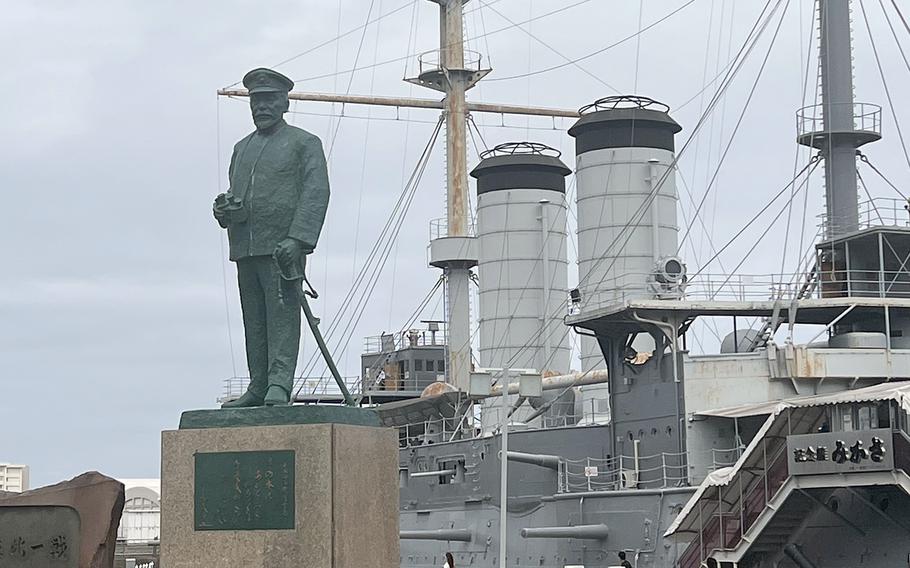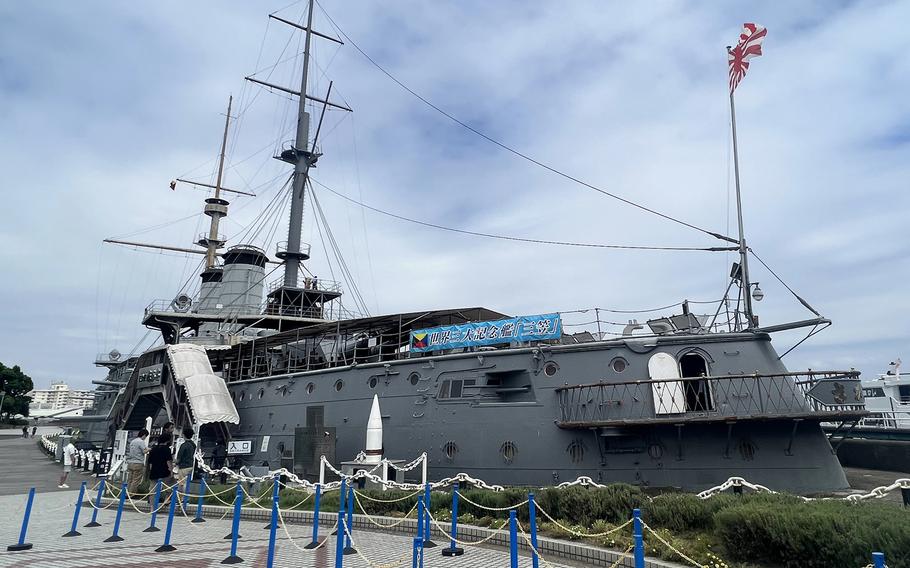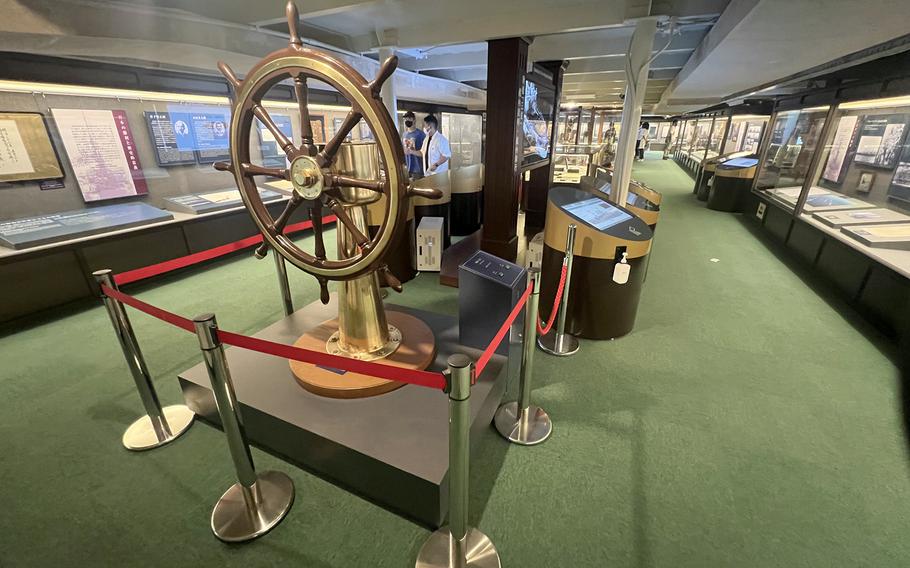
A statue of Adm. Togo Heihachiro, who rode the HMJMS Mikasa to victory in the Battle of Tsushima Strait, stands near the ship in Yokosuka, Japan. (Kelly Agee/Stars and Stripes)
The city of Yokosuka keeps a well-preserved part of Japanese naval history as a memorial to times past.
HMJMS Mikasa — 121 years old, 400 feet long and 76 feet wide — resides at Mikasa Memorial Park on the city waterfront near a statue of Adm. Togo Heihachiro, “the Nelson of the East,” who rode the Mikasa to victory in the Battle of Tsushima Strait.
The historic Japanese battleship, built and commissioned at Vickers Shipbuilding in Cumbria, England, was the flagship of the Combined Fleet that defeated Russia’s Baltic Fleet in May 1905 during the Russo-Japanese War.
Japan ultimately prevailed in the conflict, becoming the first Asian power in modern times to defeat a European power and cementing its rise as the dominant power in northeast Asia.

HMJMS Mikasa — 121 years old, 400 feet long and 76 feet wide — resides at Mikasa Memorial Park on the waterfront of Yokosuka, Japan. (Kelly Agee/Stars and Stripes)
The Mikasa was decommissioned in September 1923 under the Washington Naval Treaty, which limited the number of battleships allowed for Japan, the United States and the United Kingdom. The ship was towed to its present site in Yokosuka in 1925, where it’s now open to the public.
Battleships are known for their powerful guns, and the Mikasa does not disappoint.
On the upper deck amidships are four 3-inch guns with working screws that allow visitors to elevate the barrels.
At the bow and stern are twin 40-caliber, 12-inch gun mounting turrets. Up front, the main turret is the symbol of the battleship; it weighs 50 tons and was operated by hydraulic pressure.
From the radio room on the upper deck, sailors would transmit messages in Morse code. A display shows the alphabet in Morse code, including the most crucial code used for distress, …---… or SOS.

A model of the USS Constitution aboard the HMJMS Misaka ported in Yokosuka, Japan. (Kelly Agee/Stars and Stripes)
Visitors climb down steps to reach the main deck. A hallway display of more than 250 model ships includes the USS Constitution, the oldest ship still serving in the U.S. Navy.
U.S. sailors may also recognize a portrait of Commodore John Paul Jones who served in the Continental Navy during the American Revolutionary War. He was the captain of the USS Bohomme Richard when he uttered, “I have not yet begun to fight!” while fighting the HMS Serapis.

Artifacts, including the HMJMS Mikasa's original rudder wheel, are on display inside the ship ported in Yokosuka, Japan. (Kelly Agee/Stars and Stripes)
The museum is filled with naval uniforms, historical photos of the Mikasa and its crew, medals and artifacts from the ship, including the original rudder wheel; the ship’s bell; and Capt. Shigetake Seki’s favorite camera, which took most of the historical photos that are displayed on Mikasa.
A ship tour illustrates the life of a Japanese sailor from the early 1900s, from the mess decks, where the sailors ate, to the galley, or kitchen, and the admiral’s and captain’s cabins.
There are also fun interactive activities on the main deck, including a virtual reality simulator in which guests can experience the Battle of Tsushima Strait. A video game simulates steering and firing the ship, re-creating the battle at sea.
From the bridge, where the captain and crew managed the ship's direction and speed, is a perfect view of Tokyo Bay, including Sarushima, commonly known as Monkey Island.
The Mikasa is a perfect place for history buffs to learn about this important part of Japanese history.
On the QT
Directions: A 13-minute walk from Yokosuka-chuo Station, via the east exit. 82-19 Inaokacho Mikasa Park, Yokosuka 238-0003
Times: Open 9 a.m. to 5:30 p.m., April through September; 9 a.m. to 5 p.m., March through October; and 9 a.m. to 4:30 p.m. November through February. Closed Dec. 28-31.
Costs: Adults are 600 yen; seniors 65 and older are 500 yen; and ages 15-18 pay 300 yen
Food: The are includes cafes and restaurants, including one serving Mexican cuisine.
Information: www.kinenkan-mikasa.or.jp/en/documents/leaf_e.pdf